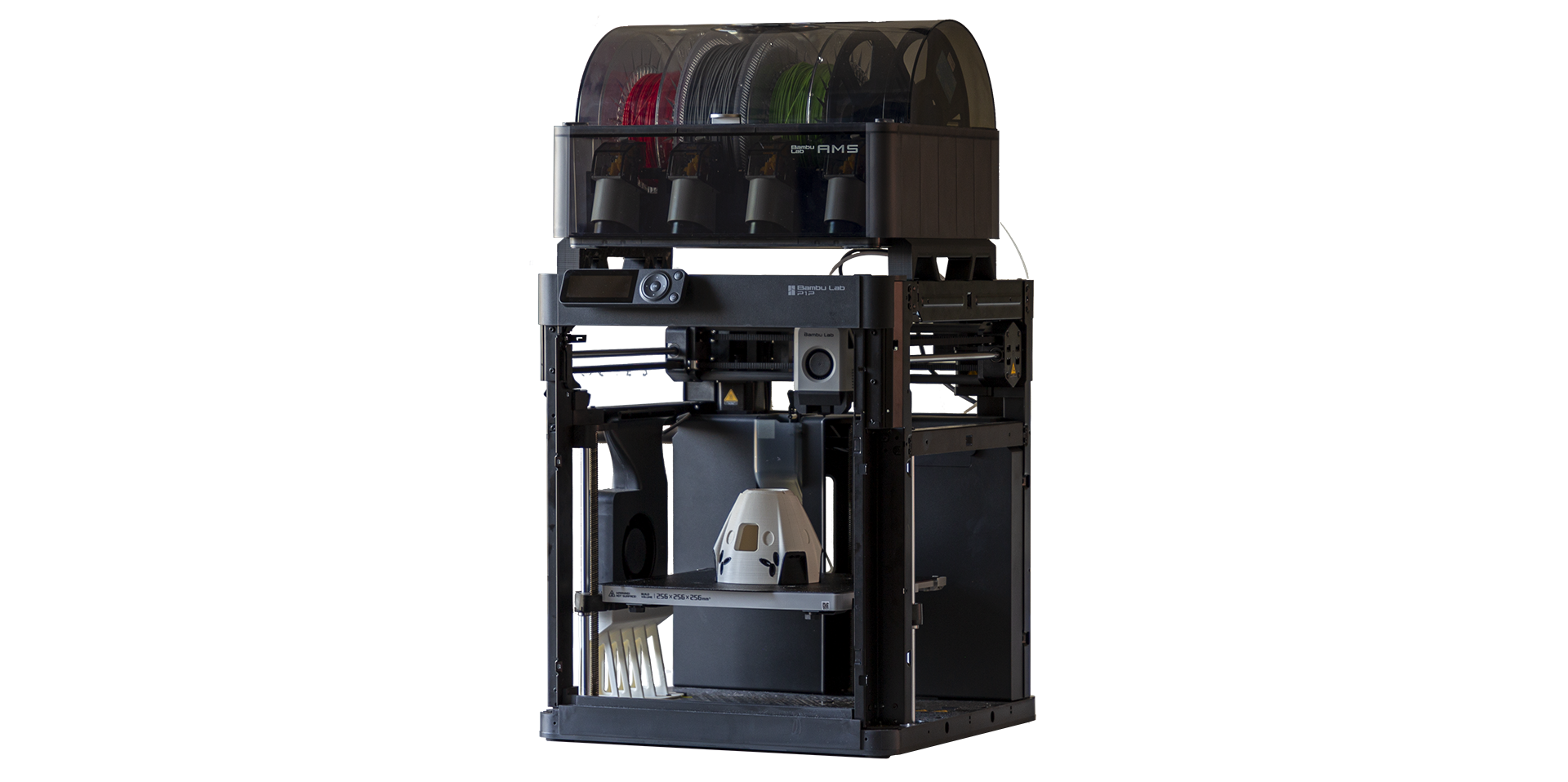Bambu labs P1P 3D Printer Review
Based on my own purchased machine 2023-2024.
Review Summary
The Good
Awesome Magnetic Plate
Slicer and App
Super fast
Geometry
Price
Automatic Material Station
Reliable
The Bad
Lack of enclosure*
Loud/noisy print fans
Not fully open source
Limited display
Support lead times
Specifications:
Build Volume: 256 x 256 x 256 mm
Extruders; 1 (up to 16 filaments in 1 print with AMS)
Extruder type: Direct Drive, All-Metal up to 300℃
Print Speed: Up to 500mm/s
Design: Core XY Construction
Nozzle size: 0.2, 0.6 and 0.8mm
Filament: 1.75 mm
Heted Buildplate (100 °C)
Optional Camera
Slicer: Bambu studio
Connections: Wifi, Bluetooth, Bambu-Bus, MicroSD
Supported OS: MacOS and Windows
File Formats: STL, OBJ, X3D, 3MF
Bambu lab P1P 3D Printer
makes fast 3D printing available to anyone.
Bambu labs disrupted the 3D Printing market with it’s kickstarter X1 3D Printer series, a really fast 3D Printer with advanced features like Lidar and sensors for extrusion.
The P1P Is the budget version without fancy enclose, Lidar, AI-detection and some sensors. It still prints equally fast and is a perfect choice for a reserved budget.
And with a smooth setup, good guides and a really simple software. This has the potential to become one of the most popular printers on the market.
Update: The P1P have more or less been replaced by the cheaper Bambu Lab A1 or the slightly more expensive but enclosed Bambu Lab P1S, Both great options that I compare in this article.
Design
The Bambu labs P1P 3D Printers design is a mix of naked hardware and “DJI” slimmed lines.
The P1P uses most parts of the more expensive X1-series, but to cut costs, none of the slimmed aluminum or glass panels are included.
This makes the printer quite naked and incomplete.
Bambu labs have tried to kickstart the community with some 3D-printable enclosures which are really cool. The best option for anyone with a P1P is probably just to save up to the P1P enclosure kit for ~$150.
Automatic Material Station
The AMS (Automatic Material Station) can be purchased separately and adds the ability to print with 4 spools at once. It sits on top of the machine on some 3D printed legs, that you print yourself.
It adds some beauty to the 3D printer in my opinion, while keeping filament clean, dry and ready for printing in multi color or multi material.
An underestimated benefit of the AMS module is the ability to just keep different materials loaded, so setup for a project is fast and efficient. Have 2 PLA spools in different color and some PETG and PC loaded for example, and you can attack most projects without manually switching filament.
The crazy thing is that you can add up to 4 AMS-systems PER printer, enabling up to 16 colors/materials in one print!
A great Multi Color experience
For me personally the AMS have been working great except for one spool (Bambu lab spool) where I tried loading a non-bambu lab refill on.
It accidently got too tight during assembly and the spool ended up not closing perfectly, and became slightly too wide which made it friction inside the AMS. Respooled it and problem was solved.
Another nice feature in the AMS is the RFID tags that come with bambu lab materials. It will just pop in and let you recognize the spool inside the slicer, and it’s location in the AMS.
Using the Bambu Lab P1P 3D Printer
I’ve had my bambu lab P1P a few months now and it has changed my perspective on 3D Printing.
I’m mostly 3D Printing my own designs, or practical things at home. My print location is in my work-from-home office. The 3D printing room i built had to go when we got our child.
This means I’m always “listening” to the printer or just having it close by. Having a fast printer suddenly made all those 5-12 hour projects actually viable, as print speeds are 2-4x faster and they can run overnight, or just don’t bother me for as long.
General operation
The P1P (and all other Bambu lab printers) are cloud based, so the day to day operations are suited for an always-connected 3D Printer. For me, this works great and I’ve had no issues after the initial setup (with the machine just being released) being a bit tricky. Nowadays, it’s more or less smooth as butter for most users.
This cloud based system lets you use both an app to monitor, and get notifications when the print is ready. this works great on my iPhone. I can leave the house and just tune in to the camera and see if it’s all going well.
Sending prints is fast and has always worked for me. There is a “backup” solution of using an SD-card if you prefer that instead.
Bambu lab Slicer
The Bambu lab slicer has had some controversy when it comes to open/closed source. I know to little about it to explain it here.
For me, as a user, the most important thing is functionality. The Bambu lab slicer works fantastically for me. Tons of settings if you run “advanced” setup, and it communicates well with the printer, sets up AMS and colors quite simply.
You may need to read through the wiki once or twice to fully get how Bambu lab uses projects, settings and syncs those to AMS. When loading a project, you can often have to map the project AMS-slots to the actual slots in your machine at the time. The saved project don’t know that you’ve swapped blue from Slot 1 to 3 for example.
Slicer Speed
The slicing is really fast on all basic projects. It’s really fast to get a fantastic overview of how much material you’ll use. This is specially important since you can see how much “poop” your multi-color prints will consume. This purging of material still needs optimization and smart inventions to be even less wastefull.
One thing I’m missing is the speed-presets that you can do on-board the machine. Taking it from normal to faster and Ludicrous.
Closed system pros and cons.
Is proprietary automatically bad? I don’t think so. Not when it works very well. The Bambu labs 3D Printers uses their own parts like hotends/nozzles that are not 3rd party compatible. The benefits are that it just works, and although you pay a bit extra for each time you need a new nozzle, it’s a smoother process for most of us.
The same goes for firmware and slicer. Although Bambu Labs slicer seems to have been copied from others, it’s incredible well thought out and works really well, with very few features one could wish for. And if there are requests, they are pretty fast at updating and adding features.
The AMS - Automatic Material Station for example, is not a open-sourced solution, and cant be “adjusted” for those who wants to. But I don’t see there a reason to either. It' works fantastically.
I can’t really recall any features that the community wants the Bambu labs 3D Printers to have. Well, other than the whole “cloud-connected-3D-printer” system. That means that although not a open-source solution, they have a great product and caters to most users needs.
Upgradability
The Bambu labs P1P comes without panels as mentioned. I suspect most new users will just pull out another $100 and buy the Bambu labs P1S instead.
But if you’re on a budget, the P1P still let’s you get going, and hopefully you can sell prints to friends and family to afford the $150 P1S upgrade kit.
less invasive upgrades are simple things like other types of build plates. There are some cool 3rd party ones coming out, with patterns and surfaces that really makes your 3D prints look cool.
Update: 3rd party hot ends are now a thing as well. For me, I’m not sure I need the hot end upgrade.
The Panda Touch is a 3rd party touch panel that fits on the P1P/P1S and is basically emulating the X1 screen.
There is also a Extension Board currently in development, that will enable deeper control for custom features. I’m really looking forward to this, to control things like Timelapse cameras or even robotic arms.
You can also upgrade your P1P with auxiliary cooling fan which I think aren’t included anymore.
Bambu labs P1P Review conclusion
I think this 3D Printer is one of the most interesting to hit the market in a long time. Finally we get a 3D Printer built for stable printing, at high speeds with a ton of materials. All at a very affordable price and easy to manage. It’s as reliable as printers 5-10x more expensive.
Although the support and general contact is hurting due to pain of growing quickly as a company, you still have a fantastic, happy community and great support wikis to help even a total novice to get going, and stay going quickly.
I wish the P1P was released as a P1S from the beginning, at the same price. It would make for a perfect 3D printer for anyone who wants a tool for their hobby or business, instead of a new hobby of tinkering with 3D Printing.
At the time of writing, Bambu labs with P1P/P1S is as close to the optimal 3D Printer for most users. Note that high-end professionals and extreme enthusiasts may still want to go other routes, the P1P/P1S really is a incredible 3D Printer.
I’m excited to see what the competition is cooking up (and they sure are) and what Bambu Labs brings next.
Update: Bambu Lab have since released Bambu Lab P1S, Bambu Lab A1 Mini and the Bambu Lab A1.






